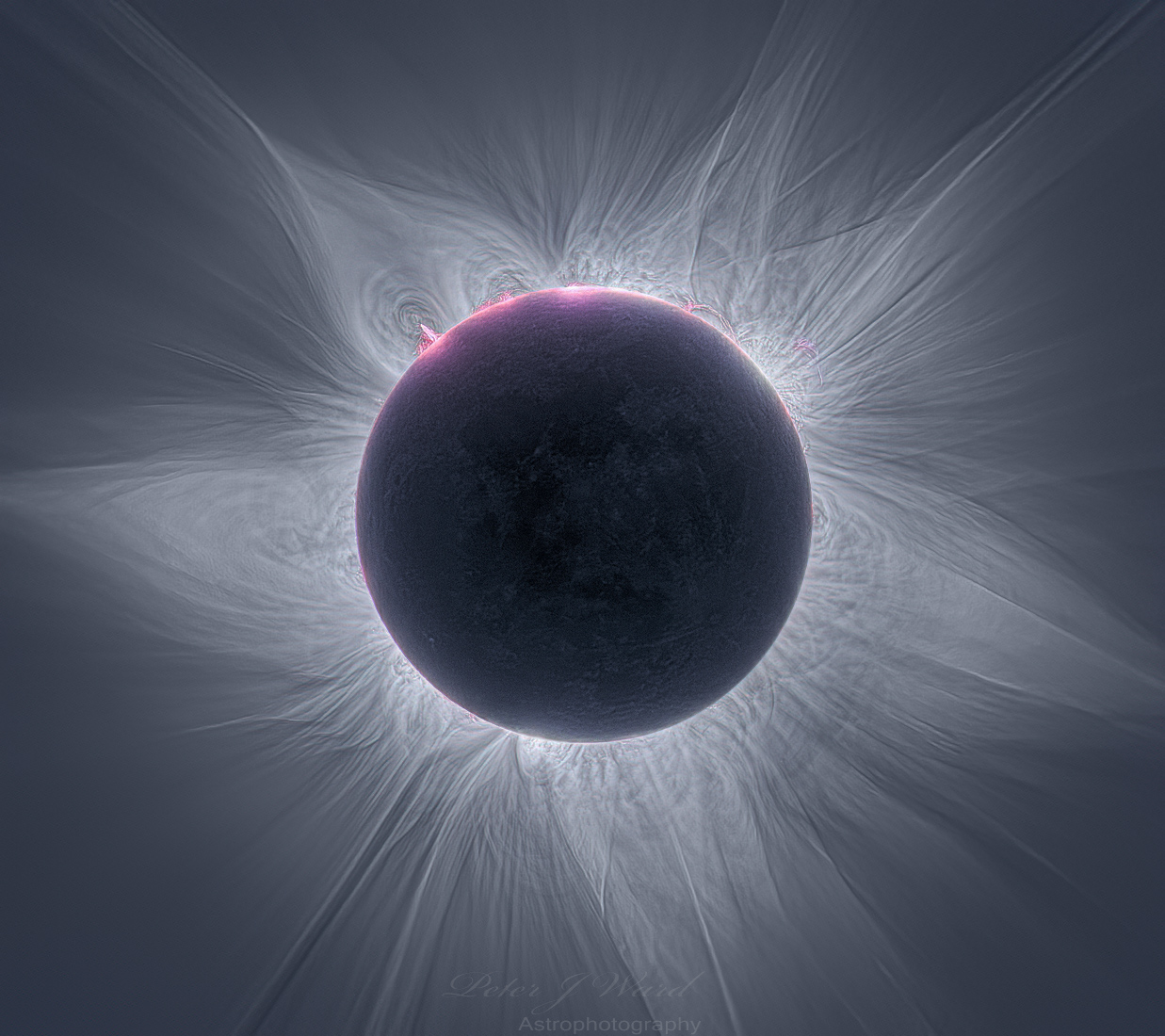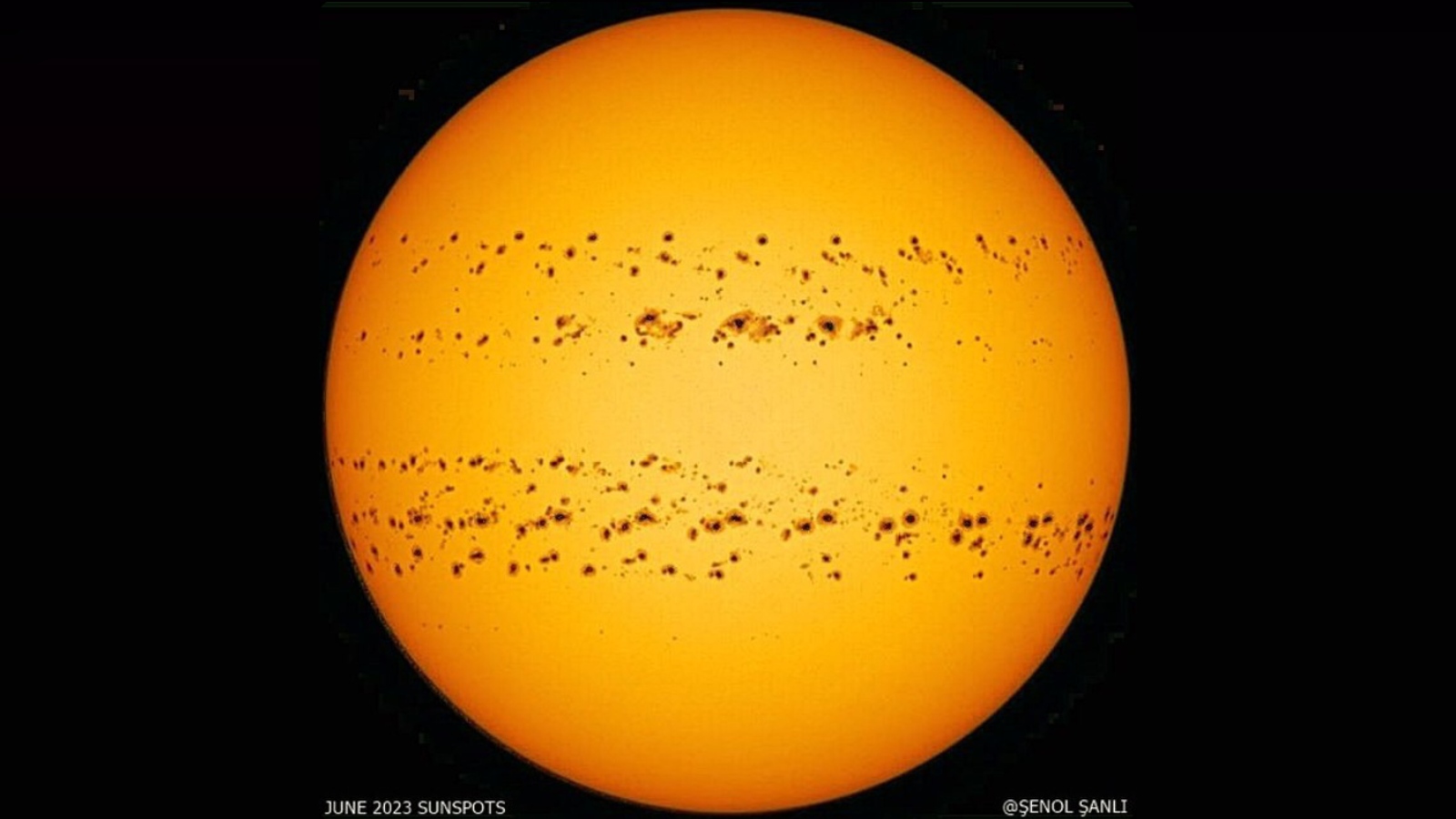Comments and questions about the
APOD on the main view screen.
-
APOD Robot
- Otto Posterman
- Posts: 5589
- Joined: Fri Dec 04, 2009 3:27 am
-
Contact:
Post
by APOD Robot » Fri Apr 05, 2024 4:05 am
 The Solar Corona Unwrapped
Explanation:
The Solar Corona Unwrapped
Explanation: Changes in the
alluring solar corona are detailed in this
creative composite image mapping the dynamic outer atmosphere of the Sun during two separate total solar eclipses. Unwrapped from the complete circle of the eclipsed Sun's edge to a rectangle and mirrored, the entire solar corona is shown during the
2017 eclipse (bottom) seen from Jackson Hole, Wyoming, and the
2023 eclipse from Exmouth, Western Australia. While the 2017 eclipse was near a minimum in the
Sun's 11 year activity cycle, the 2023 eclipse was closer to solar maximum. The 2023 solar corona hints at the dramatically different character of the active Sun, with many streamers and pinkish prominences arising along the solar limb. Of course, the solar corona is only easily visible to the eye while standing in the shadow of the Moon.
-
AVAO
- Commander
- Posts: 787
- Joined: Tue May 28, 2019 12:24 pm
- AKA: multiwavelength traveller
- Location: Zurich, Switzerland
Post
by AVAO » Fri Apr 05, 2024 5:54 am
APOD Robot wrote: ↑Fri Apr 05, 2024 4:05 am
 The Solar Corona Unwrapped
Explanation:
The Solar Corona Unwrapped
Explanation: Changes in the
alluring solar corona are detailed in this
creative composite image mapping the dynamic outer atmosphere of the Sun during two separate total solar eclipses. Unwrapped from the complete circle of the eclipsed Sun's edge to a rectangle and mirrored, the entire solar corona is shown during the
2017 eclipse (bottom) seen from Jackson Hole, Wyoming, and the
2023 eclipse from Exmouth, Western Australia. While the 2017 eclipse was near a minimum in the
Sun's 11 year activity cycle, the 2023 eclipse was closer to solar maximum. The 2023 solar corona hints at the dramatically different character of the active Sun, with many streamers and pinkish prominences arising along the solar limb. Of course, the solar corona is only easily visible to the eye while standing in the shadow of the Moon.
Very cool idea with this type of representation!
...I was just wondering whether it would make sense for the rotation- or polar-axes to be in the same place. The polar axis is very easy to identify in 2017. Interestingly, for me this is no longer really that clear in the 2023 image. Does anyone know a solution for this?
Image Credit & Copyright: Peter Ward (Barden Ridge Observatory)
http://www.atscope.com.au/BRO/bardenridgeobs.html
-
Ann
- 4725 Å
- Posts: 13837
- Joined: Sat May 29, 2010 5:33 am
Post
by Ann » Fri Apr 05, 2024 6:36 am
It looks gorgeous!

It is such a beautiful, otherworldly (that's right!!!) image. Thanks to Peter Ward for producing it.
I can tell from the picture that, indeed, the solar corona behaves differently during solar minimums and solar maximums. There is definitely more turbulence "at the bottom of the corona" and more pink flares of Hα when the Sun is more active than when it is not. But since I really have so little to say about solar eclipses in general (or the solar corona), I'm just going to shut up now and stand in for Orin Stepanek and post a solar eclipse-appropriate picture of a cat!
Oh, and... Orin, I miss you.
Ann
Color Commentator
-
Roy
Post
by Roy » Fri Apr 05, 2024 1:01 pm
Can ths be done with a coronagraph image over time, so as to highlight changes in direction and latitude of emissions?
-
Christian G.
- Science Officer
- Posts: 248
- Joined: Sat Apr 08, 2023 10:37 pm
Post
by Christian G. » Fri Apr 05, 2024 1:55 pm
The corona is the Sun's hidden glory! An eclipse is not just the Sun being eclipsed, it’s the corona being revealed!
-
Chris Peterson
- Abominable Snowman
- Posts: 18594
- Joined: Wed Jan 31, 2007 11:13 pm
- Location: Guffey, Colorado, USA
-
Contact:
Post
by Chris Peterson » Fri Apr 05, 2024 2:55 pm
Roy wrote: ↑Fri Apr 05, 2024 1:01 pm
Can ths be done with a coronagraph image over time, so as to highlight changes in direction and latitude of emissions?
To some extent, but no ground-based coronagraph can approach the dynamic range accessible during an eclipse.
One tricky point is that what we're seeing here is transient. The Sun is rotating, so we will see this entire pattern change radically over time. Over a solar cycle we would see the
strength of activity change, but the actual
positions of streaming material wouldn't compare much. Some statistical information could certainly be gleaned from such imagery.
-
Fred the Cat
- Theoretic Apothekitty
- Posts: 975
- Joined: Mon Feb 22, 2016 4:09 pm
- AKA: Ron
- Location: Eagle, Idaho
Post
by Fred the Cat » Fri Apr 05, 2024 3:34 pm
Chris Peterson wrote: ↑Fri Apr 05, 2024 2:55 pm
Roy wrote: ↑Fri Apr 05, 2024 1:01 pm
Can ths be done with a coronagraph image over time, so as to highlight changes in direction and latitude of emissions?
To some extent, but no ground-based coronagraph can approach the dynamic range accessible during an eclipse.
One tricky point is that what we're seeing here is transient. The Sun is rotating, so we will see this entire pattern change radically over time. Over a solar cycle we would see the
strength of activity change, but the actual
positions of streaming material wouldn't compare much. Some statistical information could certainly be gleaned from such imagery.
To get an idea of new attempts to use ground-based coronagraphs, check out 35 minutes into the
Nova that just aired.

Freddy's Felicity "Only ascertain as a cat box survivor"
-
johnnydeep
- Commodore
- Posts: 3226
- Joined: Sun Feb 20, 2011 8:57 pm
Post
by johnnydeep » Fri Apr 05, 2024 3:39 pm
I suppose the Sun has no meaningfully permanent longitude map that would allow these two coronal un-wrappings to be matched up. Which makes sense since the Sun is just a ball of plasma! But I gather that the rotational north-south pole line should remain the same long term. Or does it? I know the rotational speed varies with latitude, from 24 days at the equator to 38 days at the poles
--
"To B̬̻̋̚o̞̮̚̚l̘̲̀᷾d̫͓᷅ͩḷ̯᷁ͮȳ͙᷊͠ Go......Beyond The F͇̤i̙̖e̤̟l̡͓d͈̹s̙͚ We Know."{ʲₒʰₙNYᵈₑᵉₚ}
-
Chris Peterson
- Abominable Snowman
- Posts: 18594
- Joined: Wed Jan 31, 2007 11:13 pm
- Location: Guffey, Colorado, USA
-
Contact:
Post
by Chris Peterson » Fri Apr 05, 2024 3:42 pm
johnnydeep wrote: ↑Fri Apr 05, 2024 3:39 pm
I suppose the Sun has no meaningfully permanent longitude map that would allow these two coronal un-wrappings to be matched up. Which makes sense since the Sun is just a ball of plasma! But I gather that the rotational north-south pole line should remain the same long term. Or does it? I know the rotational speed varies with latitude, from 24 days at the equator to 38 days at the poles
The rotational axis is fixed. But yeah... the differential rotation makes any comparison based on "longitude" meaningless. Sunspot maps and other activity metrics are all based on latitude.
-
Ann
- 4725 Å
- Posts: 13837
- Joined: Sat May 29, 2010 5:33 am
Post
by Ann » Fri Apr 05, 2024 4:07 pm
Chris Peterson wrote: ↑Fri Apr 05, 2024 3:42 pm
johnnydeep wrote: ↑Fri Apr 05, 2024 3:39 pm
I suppose the Sun has no meaningfully permanent longitude map that would allow these two coronal un-wrappings to be matched up. Which makes sense since the Sun is just a ball of plasma! But I gather that the rotational north-south pole line should remain the same long term. Or does it? I know the rotational speed varies with latitude, from 24 days at the equator to 38 days at the poles
The rotational axis is fixed. But yeah... the differential rotation makes any comparison based on "longitude" meaningless. Sunspot maps and other activity metrics are all based on latitude.
Solar latitudes exist. For sure.
Ann
Color Commentator
-
Christian G.
- Science Officer
- Posts: 248
- Joined: Sat Apr 08, 2023 10:37 pm
Post
by Christian G. » Fri Apr 05, 2024 5:06 pm
So, in addition to being gorgeous, requiring unique conditions to be contemplated, having a mysteriously very high temperature, a wind carrying its material that shapes the tail of our comets, gives us auroras, shields us to some extent against interstellar radiation, - what else do we owe this wonderful corona?
Last edited by
Christian G. on Sat Apr 06, 2024 1:31 am, edited 1 time in total.
-
johnnydeep
- Commodore
- Posts: 3226
- Joined: Sun Feb 20, 2011 8:57 pm
Post
by johnnydeep » Fri Apr 05, 2024 5:06 pm
Ann wrote: ↑Fri Apr 05, 2024 4:07 pm
Chris Peterson wrote: ↑Fri Apr 05, 2024 3:42 pm
johnnydeep wrote: ↑Fri Apr 05, 2024 3:39 pm
I suppose the Sun has no meaningfully permanent longitude map that would allow these two coronal un-wrappings to be matched up. Which makes sense since the Sun is just a ball of plasma! But I gather that the rotational north-south pole line should remain the same long term. Or does it? I know the rotational speed varies with latitude, from 24 days at the equator to 38 days at the poles
The rotational axis is fixed. But yeah... the differential rotation makes any comparison based on "longitude" meaningless. Sunspot maps and other activity metrics are all based on latitude.
Solar latitudes exist. For sure.
Ann
Another question about the upcoming eclipse. I know a big deal is made of how the remarkably coincidental almost exact same apparent size of the Moon and Sun allows for viewing the Sun's entire corona at once and provides the best opportunity for science to study it, but wouldn't any total eclipse where the apparent size of the Moon was
greater than that of the Sun allow for just as precise a study of at least that part of the eclipse closest to the last visible portion of the Sun?
--
"To B̬̻̋̚o̞̮̚̚l̘̲̀᷾d̫͓᷅ͩḷ̯᷁ͮȳ͙᷊͠ Go......Beyond The F͇̤i̙̖e̤̟l̡͓d͈̹s̙͚ We Know."{ʲₒʰₙNYᵈₑᵉₚ}
-
Chris Peterson
- Abominable Snowman
- Posts: 18594
- Joined: Wed Jan 31, 2007 11:13 pm
- Location: Guffey, Colorado, USA
-
Contact:
Post
by Chris Peterson » Fri Apr 05, 2024 5:22 pm
johnnydeep wrote: ↑Fri Apr 05, 2024 5:06 pm
Another question about the upcoming eclipse. I know a big deal is made of how the remarkably coincidental almost exact same apparent size of the Moon and Sun allows for viewing the Sun's entire corona at once and provides the best opportunity for science to study it, but wouldn't any total eclipse where the apparent size of the Moon was
greater than that of the Sun allow for just as precise a study of at least that part of the eclipse closest to the last visible portion of the Sun?
Sure. And as you move off the centerline you also get closer to the Sun's surface along on axis. The Moon is closer to us now than it usually is during eclipses, so appears larger than the Sun... the consequence being a very long period of totality (about 5 minutes).
-
johnnydeep
- Commodore
- Posts: 3226
- Joined: Sun Feb 20, 2011 8:57 pm
Post
by johnnydeep » Fri Apr 05, 2024 5:25 pm
Chris Peterson wrote: ↑Fri Apr 05, 2024 5:22 pm
johnnydeep wrote: ↑Fri Apr 05, 2024 5:06 pm
Another question about the upcoming eclipse. I know a big deal is made of how the remarkably coincidental almost exact same apparent size of the Moon and Sun allows for viewing the Sun's entire corona at once and provides the best opportunity for science to study it, but wouldn't any total eclipse where the apparent size of the Moon was
greater than that of the Sun allow for just as precise a study of at least that part of the eclipse closest to the last visible portion of the Sun?
Sure. And as you move off the centerline you also get closer to the Sun's surface along on axis. The Moon is closer to us now than it usually is during eclipses, so appears larger than the Sun... the consequence being a very long period of totality (about 5 minutes).
Thanks. Are these "greater than total Solar eclipses" less common than annular ones?
--
"To B̬̻̋̚o̞̮̚̚l̘̲̀᷾d̫͓᷅ͩḷ̯᷁ͮȳ͙᷊͠ Go......Beyond The F͇̤i̙̖e̤̟l̡͓d͈̹s̙͚ We Know."{ʲₒʰₙNYᵈₑᵉₚ}
-
Chris Peterson
- Abominable Snowman
- Posts: 18594
- Joined: Wed Jan 31, 2007 11:13 pm
- Location: Guffey, Colorado, USA
-
Contact:
Post
by Chris Peterson » Fri Apr 05, 2024 5:32 pm
johnnydeep wrote: ↑Fri Apr 05, 2024 5:25 pm
Chris Peterson wrote: ↑Fri Apr 05, 2024 5:22 pm
johnnydeep wrote: ↑Fri Apr 05, 2024 5:06 pm
Another question about the upcoming eclipse. I know a big deal is made of how the remarkably coincidental almost exact same apparent size of the Moon and Sun allows for viewing the Sun's entire corona at once and provides the best opportunity for science to study it, but wouldn't any total eclipse where the apparent size of the Moon was
greater than that of the Sun allow for just as precise a study of at least that part of the eclipse closest to the last visible portion of the Sun?
Sure. And as you move off the centerline you also get closer to the Sun's surface along on axis. The Moon is closer to us now than it usually is during eclipses, so appears larger than the Sun... the consequence being a very long period of totality (about 5 minutes).
Thanks. Are these "greater than total Solar eclipses" less common than annular ones?
I don't know. I guess you'd have to look at all the average distances involved (Earth to Sun, Earth to Moon) and figure out whether the angular size of the Moon- on average- is larger or smaller than the Sun. Which should suggest which might be more common. FWIW, I've personally seen three annular eclipses and three total eclipses. Four if I have good conditions on Monday (which doesn't look very promising).
-
alter-ego
- Serendipitous Sleuthhound
- Posts: 1123
- Joined: Mon Apr 21, 2008 4:51 am
- Location: Redmond, WA
Post
by alter-ego » Fri Apr 05, 2024 5:46 pm
Chris Peterson wrote: ↑Fri Apr 05, 2024 5:32 pm
johnnydeep wrote: ↑Fri Apr 05, 2024 5:25 pm
Chris Peterson wrote: ↑Fri Apr 05, 2024 5:22 pm
Sure. And as you move off the centerline you also get closer to the Sun's surface along on axis. The Moon is closer to us now than it usually is during eclipses, so appears larger than the Sun... the consequence being a very long period of totality (about 5 minutes).
Thanks. Are these "greater than total Solar eclipses" less common than annular ones?
I don't know. I guess you'd have to look at all the average distances involved (Earth to Sun, Earth to Moon) and figure out whether the angular size of the Moon- on average- is larger or smaller than the Sun. Which should suggest which might be more common. FWIW, I've personally seen three annular eclipses and three total eclipses. Four if I have good conditions on Monday (which doesn't look very promising).
Six Millenium Catalog of Solar Eclipses
A pessimist is nothing more than an experienced optimist
-
Chris Peterson
- Abominable Snowman
- Posts: 18594
- Joined: Wed Jan 31, 2007 11:13 pm
- Location: Guffey, Colorado, USA
-
Contact:
Post
by Chris Peterson » Fri Apr 05, 2024 5:59 pm
alter-ego wrote: ↑Fri Apr 05, 2024 5:46 pm
Chris Peterson wrote: ↑Fri Apr 05, 2024 5:32 pm
johnnydeep wrote: ↑Fri Apr 05, 2024 5:25 pm
Thanks. Are these "greater than total Solar eclipses" less common than annular ones?
I don't know. I guess you'd have to look at all the average distances involved (Earth to Sun, Earth to Moon) and figure out whether the angular size of the Moon- on average- is larger or smaller than the Sun. Which should suggest which might be more common. FWIW, I've personally seen three annular eclipses and three total eclipses. Four if I have good conditions on Monday (which doesn't look very promising).
Six Millenium Catalog of Solar Eclipses
6 Millenium Solar Eclipse Summary.jpg
Which suggests that the Moon is, on average, just a bit smaller than the Sun, slightly boosting the number of annular eclipses over total ones.
-
johnnydeep
- Commodore
- Posts: 3226
- Joined: Sun Feb 20, 2011 8:57 pm
Post
by johnnydeep » Fri Apr 05, 2024 6:01 pm
Chris Peterson wrote: ↑Fri Apr 05, 2024 5:59 pm
alter-ego wrote: ↑Fri Apr 05, 2024 5:46 pm
Chris Peterson wrote: ↑Fri Apr 05, 2024 5:32 pm
I don't know. I guess you'd have to look at all the average distances involved (Earth to Sun, Earth to Moon) and figure out whether the angular size of the Moon- on average- is larger or smaller than the Sun. Which should suggest which might be more common. FWIW, I've personally seen three annular eclipses and three total eclipses. Four if I have good conditions on Monday (which doesn't look very promising).
Six Millenium Catalog of Solar Eclipses
6 Millenium Solar Eclipse Summary.jpg
Which suggests that the Moon is, on average, just a bit smaller than the Sun, slightly boosting the number of annular eclipses over total ones.
Thanks, guys!
--
"To B̬̻̋̚o̞̮̚̚l̘̲̀᷾d̫͓᷅ͩḷ̯᷁ͮȳ͙᷊͠ Go......Beyond The F͇̤i̙̖e̤̟l̡͓d͈̹s̙͚ We Know."{ʲₒʰₙNYᵈₑᵉₚ}
-
VictorBorun
- Captain
- Posts: 1136
- Joined: Fri Oct 16, 2020 10:25 pm
-
Contact:
Post
by VictorBorun » Sat Apr 06, 2024 4:40 pm
johnnydeep wrote: ↑Fri Apr 05, 2024 3:39 pm
I suppose the Sun has no meaningfully permanent longitude map that would allow these two coronal un-wrappings to be matched up. Which makes sense since the Sun is just a ball of plasma! But I gather that the rotational north-south pole line should remain the same long term. Or does it? I know the rotational speed varies with latitude, from 24 days at the equator to 38 days at the poles
Sun's flattening is 0.00005 = 1/20,000
If we stitch a 20k pixels × 20k pixels panorama of Sun, we will know the equatorial diameter by being a pixel wider than the pole-to-pole one.
-
johnnydeep
- Commodore
- Posts: 3226
- Joined: Sun Feb 20, 2011 8:57 pm
Post
by johnnydeep » Sat Apr 06, 2024 4:45 pm
VictorBorun wrote: ↑Sat Apr 06, 2024 4:40 pm
johnnydeep wrote: ↑Fri Apr 05, 2024 3:39 pm
I suppose the Sun has no meaningfully permanent longitude map that would allow these two coronal un-wrappings to be matched up. Which makes sense since the Sun is just a ball of plasma! But I gather that the rotational north-south pole line should remain the same long term. Or does it? I know the rotational speed varies with latitude, from 24 days at the equator to 38 days at the poles
Sun's flattening is 0.00005 = 1/20,000
If we stitch a 20k pixels × 20k pixels panorama of Sun, we will know the equatorial diameter by being a pixel wider than the pole-to-pole one.
Ok, but it would still not be possible to determine a fixed longitudinal coordinate since there isn't one. And this would apply to any ball of rotating gas/plasma in the center of which we are unable to find - and map - a solid core.
--
"To B̬̻̋̚o̞̮̚̚l̘̲̀᷾d̫͓᷅ͩḷ̯᷁ͮȳ͙᷊͠ Go......Beyond The F͇̤i̙̖e̤̟l̡͓d͈̹s̙͚ We Know."{ʲₒʰₙNYᵈₑᵉₚ}
-
VictorBorun
- Captain
- Posts: 1136
- Joined: Fri Oct 16, 2020 10:25 pm
-
Contact:
Post
by VictorBorun » Sat Apr 06, 2024 5:35 pm
johnnydeep wrote: ↑Sat Apr 06, 2024 4:45 pm
VictorBorun wrote: ↑Sat Apr 06, 2024 4:40 pm
johnnydeep wrote: ↑Fri Apr 05, 2024 3:39 pm
I suppose the Sun has no meaningfully permanent longitude map that would allow these two coronal un-wrappings to be matched up. Which makes sense since the Sun is just a ball of plasma! But I gather that the rotational north-south pole line should remain the same long term. Or does it? I know the rotational speed varies with latitude, from 24 days at the equator to 38 days at the poles
Sun's flattening is 0.00005 = 1/20,000
If we stitch a 20k pixels × 20k pixels panorama of Sun, we will know the equatorial diameter by being a pixel wider than the pole-to-pole one.
Ok, but it would still not be possible to determine a fixed longitudinal coordinate since there isn't one. And this would apply to any ball of rotating gas/plasma in the center of which we are unable to find - and map - a solid core.
to trace a map with longitudes we must record a continuous video.
There is a clock choice problem, similar to the one for a time zone for Moon:
• more rotations counted for Sun's equator than Sun's poles
• more clock pulses counted by an atomic clock on Moon than on Earth
We will have to create a currency basket with some weights for two counts or discard one count altogether in favour of the other one.
-
johnnydeep
- Commodore
- Posts: 3226
- Joined: Sun Feb 20, 2011 8:57 pm
Post
by johnnydeep » Sat Apr 06, 2024 5:41 pm
VictorBorun wrote: ↑Sat Apr 06, 2024 5:35 pm
johnnydeep wrote: ↑Sat Apr 06, 2024 4:45 pm
VictorBorun wrote: ↑Sat Apr 06, 2024 4:40 pm
Sun's flattening is 0.00005 = 1/20,000
If we stitch a 20k pixels × 20k pixels panorama of Sun, we will know the equatorial diameter by being a pixel wider than the pole-to-pole one.
Ok, but it would still not be possible to determine a fixed longitudinal coordinate since there isn't one. And this would apply to any ball of rotating gas/plasma in the center of which we are unable to find - and map - a solid core.
to trace a map with longitudes we must record a continuous video.
There is a clock choice problem, similar to the one for a time zone for Moon:
• more rotations counted for Sun's equator than Sun's poles
• more clock pulses counted by an atomic clock on Moon than on Earth
We will have to create a currency basket with some weights for two counts or discard one count altogether in favour of the other one.
Hmm, I suppose that could actually work? Start recording the Sun's rotation nonstop from time T₀, and then use it to keep track. Would only be useful from that time on though.
--
"To B̬̻̋̚o̞̮̚̚l̘̲̀᷾d̫͓᷅ͩḷ̯᷁ͮȳ͙᷊͠ Go......Beyond The F͇̤i̙̖e̤̟l̡͓d͈̹s̙͚ We Know."{ʲₒʰₙNYᵈₑᵉₚ}
 The Solar Corona Unwrapped
The Solar Corona Unwrapped




